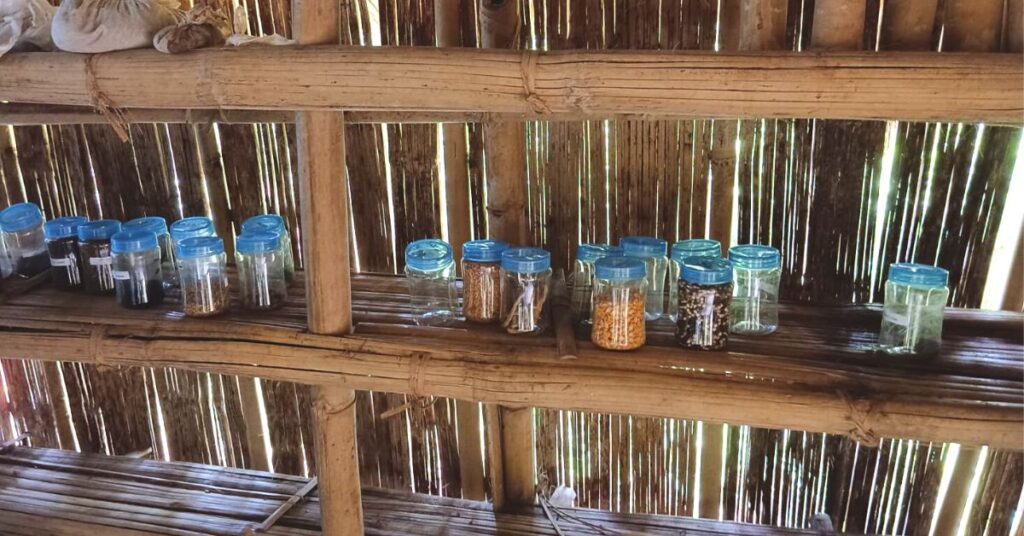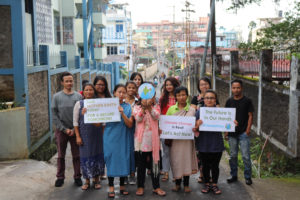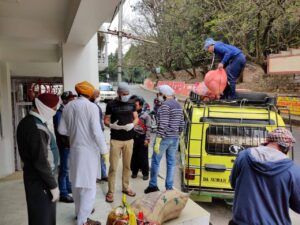Not very far from the ‘Pnah Kyndeng Sanctuary Bat Caves’ in Raid Nonglyngdoh (Ri-Bhoi) is the village of Pahamshiken. A quintessential Bhoi village with lots of greenery, beautifully laid paddy fields and fish ponds adjoining the homestead, since 2020 it houses a Community Seed Bank. Managed by a group of 10 women farmers, this particular seed bank was inaugurated by Social Service Centre (SSC) as part of the REC-supported project “No One Shall be Left Behind Initiative: Biodiversity for Food, Nutrition and Energy Security, Meghalaya and Nagaland” in working in collaboration with NESFAS (North East Slow Food and Agrobiodiversity Society). Currently it holds around 20 types of seeds, e.g., maize, job’s tears, coriander, beans, rice, pumpkin among others. But at other times, particularly after harvest, the seed bank has held more than 100 types of seeds. This has been made possible by the tremendous amount of agrobiodiversity that Ri-Bhoi contains. The district in fact contained the highest amount of agrobiodiversity, an average of more than 250 food plants per village, as found by the 2018 participatory mapping exercise conducted by NESFAS and SSC in Meghalaya and Nagaland. This made Pahamshiken very appropriate for establishing the seed bank.
According to the 2015 book ‘Community Seed Banks: Origin, Evolution and Prospects’ edited by Ronnie Vernooy, Pitambar Shrestha and Bhuwon Sthapit, Community Seed Banks are an important agrobiodiversity conservation initiative. They have been around for more than 30 years and are found throughout the world. Countries like Brazil, Nepal, India and Nicaragua have a large number of them but others such as Bhutan, Bolivia, Burkina Faso, China, Guatemala, Rwanda and Uganda have only a few emerging ones. The main aim of these institutions is to conserve local or ‘farmer’ varieties and rare varieties before this genetic diversity is lost because of societal pressures or frequent natural disasters. For example, in Bhutan, the Community Seed Bank was established in 2011 to arrest the decline of traditional staple crops like bitter buckwheat, sweet buckwheat and barley. In Ethiopia, on the other hand, the initiative was launched in 1989 with the aim to work in partnership with local farmers to rebuild the local food system that had been severely affected by drought. Similar motivations also promoted the establishment of the Community Seed Bank in Pahamshiken.

For the women farmers of Pahamshiken, loss of traditional varieties and the need to strengthen the local food system were the main motivations for starting the seed bank. For example, job’s tears (sorisip) which had nearly become extinct are now stored with the intention to revive its cultivation in the village. This is true of certain paddy varieties as well whose cultivation had declined over time. Ri-Bhoi is well known for paddy cultivation with multiple varieties being grown by farmers in the villages. In Pahamshiken itself more than two dozen varieties are being cultivated. Out of these, kba sohtri is a variety which was in decline but has now been brought to the seed bank for revival. This particular variety, as revealed by Kong Dafimery Lyngdoh (Secretary of the women farmers’ group managing the seed bank), can tolerate a high degree of climate stress. This is a very important attribute considering climate change has already led to extreme weather conditions becoming very frequent. This year itself, intensive rainfall led to landslides and flash floods that destroyed not just infrastructures but also resulted in loss of precious human lives. Agricultural yield was badly impacted in many areas of the State as well. As such, the particular paddy variety, i.e., kba sohtri being conserved in the seed bank, could be a potential climate change adaptation solution as it has been reported to withstand severe climate stress. More importantly, with the impact of climate change predicted to intensify in the coming decades, this could be a crucial solution not just for the village of Pahamshiken and others in the Raid Nonglyngdoh area but for global food security as well.
The 2019 IPCC ‘Special Report on Climate Change and Land’ has made some dire predictions about the future of food security. The report has observed that there is a high degree of confidence that climate change is already affecting food security through increasing temperatures, changing precipitation patterns, and greater frequency of some extreme events. Subsequently, future global food security will also be greatly affected. This will be true for India as well. The 2016 paper ‘Climate Change and Food Security in India’ by M. Chakrabarty has stated that acute water shortage conditions, together with thermal stress (both outcomes of climate change) will affect rice productivity very severely in the country.
However, not everything is doom and gloom. The same IPCC report also states that there is a high degree of confidence that sustainable practices can be optimised and scaled up to advance adaptation throughout the food system. This is where the motivations behind starting the Community Seed Bank in Pahamshiken and conserving paddy varieties like kba sohtri can play a crucial role, especially through the biodiversity present in the local food system.
The path breaking 2021 ‘White/Wiphala Paper on Indigenous Peoples’ food systems’ prepared by Indigenous Peoples’ representatives and experts, scientists, researchers, and UN staff has found that the biodiversity rich Indigenous People’s Food System (IPFS), of which the food system in Pahamshiken is a part of, can greatly contribute to strengthening the resilience of the global food system. The diversity inherent in IPFS provides insurance against resource failure by sheltering the food system from the impact of ecological shocks. The multiplicity of food sources ensures that if one source is affected, the others can compensate for it. In Pahamshiken, people have a variety of food sources, viz., paddy fields, homegarden, water bodies and forest. From these sources more than 200 food plants can be harvested at different times of the year. This is supplemented by animals, both domesticated and wild along with insects and aquatic creatures from the water bodies. This diversity further helps in strengthening resilience because it contains food resources that have adapted to the local conditions and various climatic stresses over longer time frames through evolutionary process, i.e., climate resilient species and breeds. The paddy variety kba sohtri is a good example of this. Most probably, there could even be more. The Community Seed Bank in Pahamshiken, by helping in strengthening the IPFS, can thus not only contribute to local food security but hold important resources for global food security as well, present and future.
Apart from food security the seeds stored in the Community Seed Bank have other significance as well. For the women managing the seed bank, the seeds stored are not just about food but are tied to the cultural identity and value systems of the local indigenous community. The members were asked as to how they make sure members do not steal the seeds kept in the seed bank particularly that of rice. Kong Dafimery Lyngdoh replied that rice is Lukhmi and there is a belief among the people in the area that anyone who steals the seeds will face misfortune. Lukhmi is the Khasi version of the Hindu Goddess- Lakshmi, Goddess of wealth and prosperity. Just like Hinduism appropriated the local Gods of the different regions of the subcontinent into their pantheon (thus the millions of Gods in Hinduism), the Khasis also appropriated the name of Hindu Gods into their own. Since Lukhmi (Lakshmi) symbolizes wealth, if one unfairly deprives someone of their wealth (stealing of seeds) misfortune will visit upon them. In short, don’t steal from other people. For the people of Pahamshiken, the seeds kept in the seed bank are not only food but also determine who they are and what they believe in.
The Community Seed Bank in Pahamshiken can help in ensuring food security, contribute to strengthening the resilience of the food system to cope with climate change and keep alive the tradition and value systems of indigenous peoples. But for all of this to happen it will need the support of the State Government. In fact, Community Seed Banks can be part of the iniatives to put the State on the path to sustainable agriculture (as suggested by the IPCC report) and place Meghalaya at the forefront of the fight against climate change, making it an important leader in that national and global effort.
This article was originally published in the Highland Post



